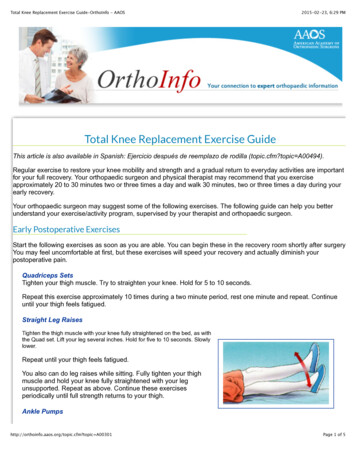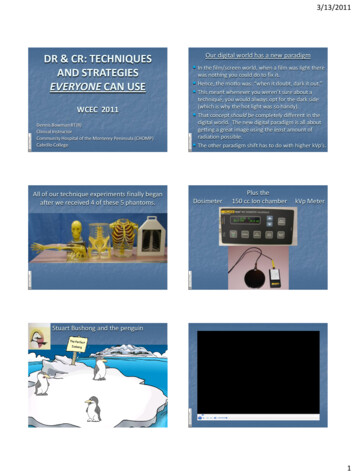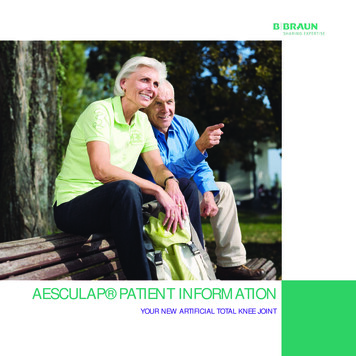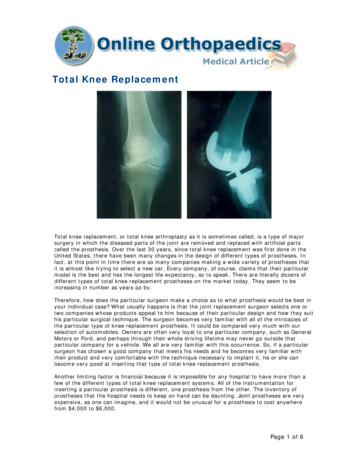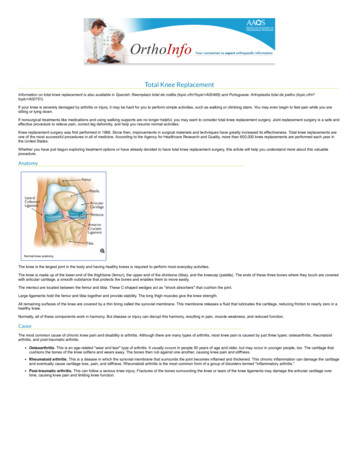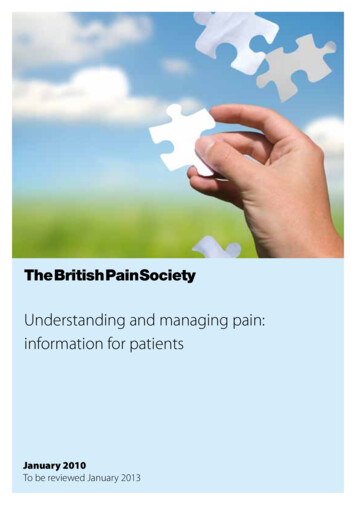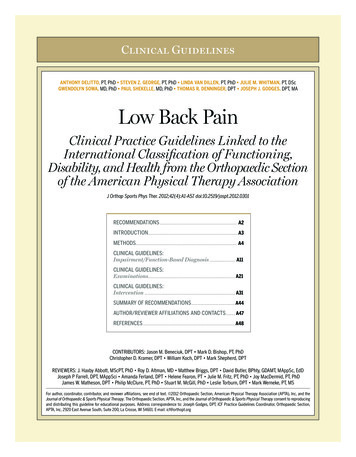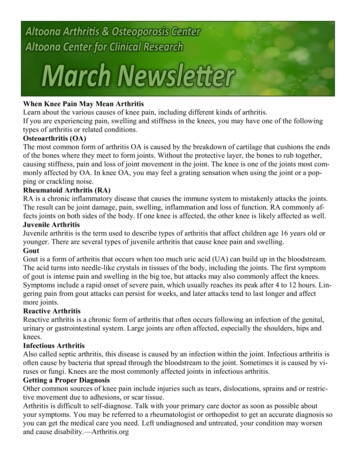
Transcription
When Knee Pain May Mean ArthritisLearn about the various causes of knee pain, including different kinds of arthritis.If you are experiencing pain, swelling and stiffness in the knees, you may have one of the followingtypes of arthritis or related conditions.Osteoarthritis (OA)The most common form of arthritis OA is caused by the breakdown of cartilage that cushions the endsof the bones where they meet to form joints. Without the protective layer, the bones to rub together,causing stiffness, pain and loss of joint movement in the joint. The knee is one of the joints most commonly affected by OA. In knee OA, you may feel a grating sensation when using the joint or a popping or crackling noise.Rheumatoid Arthritis (RA)RA is a chronic inflammatory disease that causes the immune system to mistakenly attacks the joints.The result can be joint damage, pain, swelling, inflammation and loss of function. RA commonly affects joints on both sides of the body. If one knee is affected, the other knee is likely affected as well.Juvenile ArthritisJuvenile arthritis is the term used to describe types of arthritis that affect children age 16 years old oryounger. There are several types of juvenile arthritis that cause knee pain and swelling.GoutGout is a form of arthritis that occurs when too much uric acid (UA) can build up in the bloodstream.The acid turns into needle-like crystals in tissues of the body, including the joints. The first symptomof gout is intense pain and swelling in the big toe, but attacks may also commonly affect the knees.Symptoms include a rapid onset of severe pain, which usually reaches its peak after 4 to 12 hours. Lingering pain from gout attacks can persist for weeks, and later attacks tend to last longer and affectmore joints.Reactive ArthritisReactive arthritis is a chronic form of arthritis that often occurs following an infection of the genital,urinary or gastrointestinal system. Large joints are often affected, especially the shoulders, hips andknees.Infectious ArthritisAlso called septic arthritis, this disease is caused by an infection within the joint. Infectious arthritis isoften cause by bacteria that spread through the bloodstream to the joint. Sometimes it is caused by viruses or fungi. Knees are the most commonly affected joints in infectious arthritis.Getting a Proper DiagnosisOther common sources of knee pain include injuries such as tears, dislocations, sprains and or restrictive movement due to adhesions, or scar tissue.Arthritis is difficult to self-diagnose. Talk with your primary care doctor as soon as possible aboutyour symptoms. You may be referred to a rheumatologist or orthopedist to get an accurate diagnosis soyou can get the medical care you need. Left undiagnosed and untreated, your condition may worsenand cause disability.—Arthritis.org
Everyone has a dry mouth now and then – from nerves, stress, too much exercise or too little water.But if your dry mouth doesn’t go away – no matter how much water you drink – the problem may liewith your salivary glands. Chronic dry mouth (xerostomia) occurs when your salivary glands don’tproduce enough saliva to keep your mouth moist. Your lips and the skin around them may dry andcrack, too, and you might find it hard to talk or swallow.Medications and Dry MouthLots of things can contribute to a chronically dry mouth, but medications are the main culprit. Morethan 500 prescription and over-the-counter (OTC) drugs affect how your salivary glands work. If yourmouth feels like it’s permanently stuffed with cotton, start by checking the side effects of your medications or ask your doctor about them. Antihistamines Antidepressants Antipsychotics Blood pressure pills Diuretics Pain relievers SedativesSjogren’s Syndrome and Dry MouthDrugs and aging are the most common causes of dry mouth. But if you have rheumatoid arthritis(RA) or lupus you’re also at increased risk of Sjogren’s syndrome, an autoimmune disorder whosemain symptoms are dry mouth and eyes.For years, Sjogren’s was considered a nuisance condition that didn’t cause serious problems. It’s nowknown that it can also affect your joints, kidneys, lungs, skin and cause ongoing fatigue. Like otherautoimmune diseases, Sjogren’s occurs when inflammation is directed against the body’s own tissues– in this case, the glands that produce moisture in your mouth and eyes.There are two types of Sjogren’s syndrome – primary and secondary. Primary is when you haveSjögren’s symptoms but you don’t have another major rheumatic or autoimmune disease. The secondary form is diagnosed when someone who already has another autoimmune disease, such as RA orlupus, develops Sjogren’s symptoms. Dry mouth symptoms tend to be worse in primary Sjogren’s.Dangers of Dry MouthDry mouth is uncomfortable and can present daily challenges, including the inability to taste or enjoyfood. More important, it affects your oral health and digestion. Saliva contains antibacterial compounds that prevent tooth decay, gum disease and bad breath. It also makes chewing and swallowingeasier and contains the enzyme amylase, which helps break down starches.“Operating a mouth with no spit is like driving a car without motor oil,” explains Anna Diaz-Arnold,DDS, a professor in the Department of Family Dentistry at the University of Iowa.
Dry Mouth TreatmentThe goal of treatment is to keep your mouth as moist as possible. Most therapies are simple thingsyou can do yourself, others will require a prescription. Take small sips of water throughout the day. Chew sugar-free gum. This will help keep as much saliva flowing as possible. Invest in a room humidifier. A moist environment can help your skin, mouth and eyes. Try saliva substitutes. These come as sprays, gels and lozenges and are sold online and in mostpharmacies. Some contain xylitol, which can help protect against cavities but may also causestomach upset. You might want to stick with products made from carboxymethylcellulose or hydroxyethylcellulose. Your dentistcan probably suggest a goodbrand. Avoid sugary foods and candies.Lower your risk of cavities byavoiding these. Limit caffeine. It can make drymouth worse. Try prescription medicines. Twomedications are approved tostimulate saliva production inpeople with Sjogren’s: cevimeline HCL (Evoxac) and pilocarpine (Salagen). These medications are usually only tried ifnothing else has worked. Bothhave side effects and interactwith a host of other drugs, so talkto your doctor about the risks andbenefits. Get frequent dental care. Youmay need more-frequent cleanings and dental examinations.Your dentist may also suggestanti-cavity toothpaste and otherproducts to help keep yourmouth healthy.—Arthritis.org
By Terrie Heinrich RizzoHow to Avoid Back InjuryTwisting at the waist, especially when bending or carrying something, is a prime cause of back painand injury. You can reduce these risks by making sure your hips, knees and shoulders always move inthe same direction.Here are a few more specific movement basics for pain prevention and management to use during your daily activities:Getting out of bed: Roll onto your side and bend both knees toward your chest in a loose fetal position. With your hands, push your upper body into a sitting position, and move your legs so theyhang over the edge of the bed. Rest a moment if needed, then carefully slide off the edge of the bed until you can firmly placeyour feet on the floor, hip- to shoulder-width apart . Stand up, keeping your back straight.Loading and unloading: Keep loads small. It’s OK to make severaltrips. Carry loads close to your torso. Keep a straight back as you lift, carry and unload, and use your larger muscles and legs todo most of the work. Take several steps to turn around, instead ofpivoting on your feet or twisting your upperbody.Shoveling and sweeping: Make sure your feet and the buckle on your beltface your shovel or broom. Take steps, walking along with the shovel orbroom as you move it. Do not stretch out withyour arms and back. When possible, push loads to the side ratherthan lifting them.Keep these smart movement tips in mind whengoing about your daily tasks to help keep yourback and joints safe.—Arthritis.org
IngredientsPeanut butter filling:1 1/4 cups (336 grams) creamy conventional peanutbutter (NOT 'natural')**Brownies:10 tablespoons (142 grams) unsalted butter4 ounces (113 grams) semisweet baking chocolate,chopped1 cup (200 grams) granulated sugar2 large eggs plus 1 egg yolk1 teaspoon vanilla extract1/2 cup (64 grams) all-purpose flour1/4 cup (25 grams) unsweetened cocoa powder, sifted1/4 teaspoon fine saltDirectionsMake the peanut butter filling:Place the peanut butter in a heat safe bowl and microwave for 20 to 30 seconds, or until pourable but notsuper hot.Line a metal 8-inch square pan with parchment paper,leaving an overhang. Spread the peanut butter into aneven layer in the pan. Freeze for 1 hour or until solidified. Use the parchment to remove from pan andreturn peanut butter sheet to freezer. Keep frozen while making the brownie batter.Make the brownies:Preheat oven to 350 Line the square pan again with parchment paper, leaving an overhang.In a large microwave-safe bowl combine the butter and chocolate. Microwave in 30-second bursts,stirring between each burst, until the mixture is melted and smooth. Add the sugar to the hot buttermixture and whisk vigorously until combined. Allow to cool until just barely warm.Add in eggs, yolk, and vanilla extract and whisk for about 1 minute, or until very well combined.Use a rubber spatula to stir in flour, cocoa powder, and salt until just combined.Pour half of the batter into prepared pan and smooth out. Carefully place the frozen peanut buttersheet over the batter. Pour remaining batter on top, covering completely.Bake in the preheated oven for about 30 minutes, or until cooked through but still very slightly gooeyin the center. Let cool in pan 30 minutes. Remove from pan and allow to cool for another 30 minutesbefore slicing and serving.Brownies can be stored in an airtight container at room temperature for up to 3 days or in the fridgefor up to 5 days. Serving chilled makes the brownies extra fudgy! - Peanut Butter Stuffed Brownies Handle the Heat
Stephanie, Certified Medical AssistantStephanie has been with the Altoona Arthritis & Osteoporosis Centerfor 9 years. She joined our office while she was studying to become a Certified Medical Assistant (CMA). As a CMA Stephanie focuses on patientcare as well as attending to normal front office and administrative duties tohelp keep the office running smoothly. Her average day consists of providing patients with medication education/trainings, administering injectionsand keeping our electronic medical record system up-to-date.Working with patients on a daily basis is an aspect of Stephanie’s job duties that she greatlyenjoys. The fact that she has the ability to change or make a person’s life better by helping peopleovercome challenges they may face due to their rheumatic conditions is something that she takes greatpride in. She is part of a great team that works together to help each individual patient with these challenges. This team, Stephanie feels, works extremely well together to keep the office running asproperly as possible. She has found this team to be an amazing work family and friend group that shehas gained through her time here. Stephanie’s mom is also an integral part of our office and hasworked for AAOC for 31, coming up on 32 years.Not only does Stephanie have a great work family in office, she also has a new family of herown that keeps her on her toes. In her free time she has a brand new baby that she and her husbandadore. Thankfully, Stephanie loves to be outside, as she has her “second child” (her adorable dog), aswell as a group of chickens that require her time and attention.
Stephanie has been with the Altoona Arthritis & Osteoporosis Center for 9 years. She joined our office while she was studying to become a Certi-fied Medical Assistant (CMA). As a CMA Stephanie focuses on patient care as well as attending to normal front office and administrative duties to help keep the office running smoothly.



